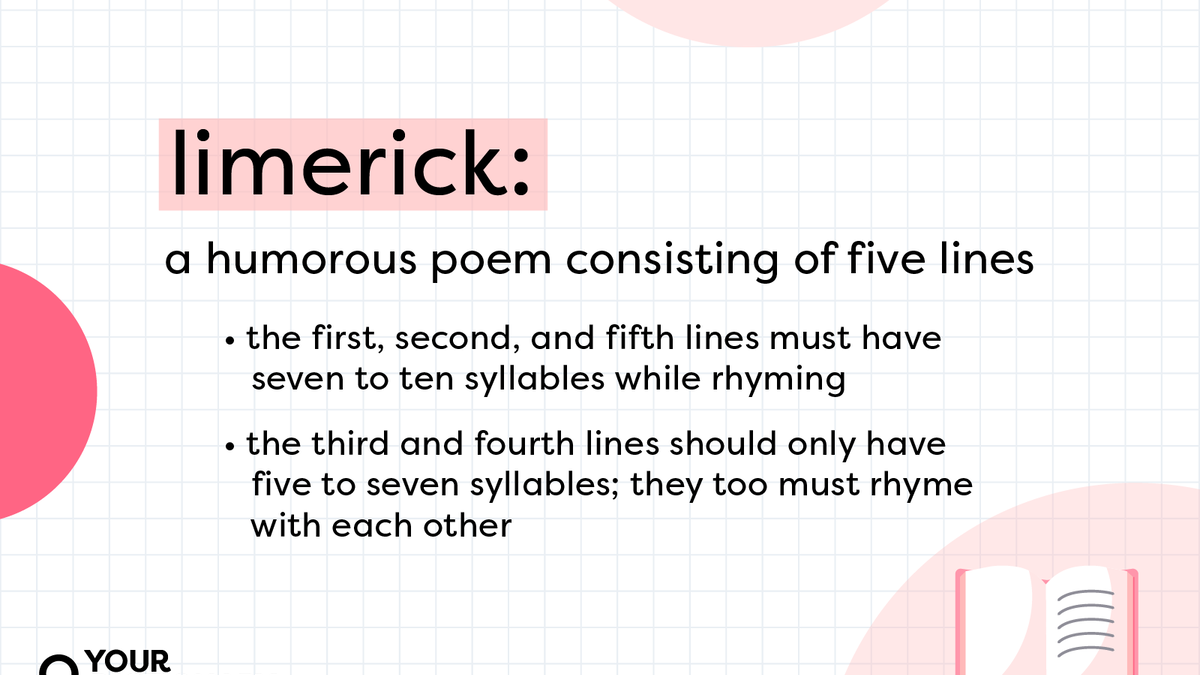
I still remember the first limerick I ever heard. It was something silly about a man from Peru, and it had me giggling for days. It wasn’t long before I tried writing one myself—bad rhymes and all. But that’s the thing about limericks: they’re supposed to be fun. A little cheeky, a little clever, and endlessly entertaining.
If you’ve ever wondered how to write one—or just want to enjoy the magic of this quirky poetic form—you’re in the right place. Let’s break down what makes a limerick tick and how to write your own in just five lines.
🎭 What Is a Limerick?

A limerick is a short, humorous poem with five lines, a distinct rhythm, and a specific rhyme scheme. It’s known for its:
-
Playful tone
-
Witty or absurd content
-
Bouncy rhythm that’s super satisfying to read out loud
They’re often nonsense poems, but some can sneak in social commentary or clever wordplay. Either way, they’re all about fun, rhythm, and rhyme.
✍️ Limerick Structure: The 5-Line Formula
Here’s what makes a limerick… well, a limerick:
📐 Format:
-
Five lines total
-
Rhyme scheme: AABBA
-
Lines 1, 2, and 5 have three beats (typically 8–9 syllables)
-
Lines 3 and 4 have two beats (typically 5–6 syllables)
🧠 Example:
There once was a cat from Belize (A)
Who sailed the world with great ease (A)
He fell off the deck (B)
And got quite a peck (B)
From dolphins who swam in the seas (A)
It’s silly. It rhymes. It follows the rhythm. That’s a limerick!
😂 What Makes Limericks So Fun?
Limericks are light. They’re weird. And they break the rules just enough to keep things knowledge interesting. Here’s why they’ve stuck around for centuries:
-
Easy to memorize (great for kids and classrooms)
-
A gateway to poetry for beginners
-
Perfect for humor and surprise endings
-
Encourage creativity and wordplay
You don’t need a deep theme or fancy vocabulary. Just a setup, a twist, and a smile.
📜 A Quick History of Limericks
The exact origin of limericks is a bit murky, but they became wildly popular in 19th-century England—especially thanks to Edward Lear, whose Book of Nonsense (1846) introduced whimsical limericks to children and adults alike.
Lear’s limericks usually started with “There was a…” and featured absurd characters in strange situations.
There was an Old Man with a beard,
Who said, “It is just as I feared!
Two owls and a hen,
Four larks and a wren,
Have all built their nests in my beard!”
His poems were more about rhythm and silliness than perfect structure—but that’s part of the charm.
✏️ How to Write Your Own Limerick
If you’ve never written a limerick before, don’t worry—you can start right now. Here’s a step-by-step guide:
1. Start with a Person and a Place
The classic opening is “There once was a [person] from [place]…” Example: “There once was a girl from Kent…”
2. Set Up the Scenario
Line 2 should rhyme with line 1 and add more detail. “There once was a girl from Kent / Who lived in a lavender tent…”
3. Add a Twist or Conflict
Lines 3 and 4 are shorter and rhyme with each other. Build tension or absurdity. “She danced in the breeze, / With butterflies and bees…”
4. Finish with a Funny or Unexpected Ending
Line 5 returns to the original rhyme and ties it all together. “And was stung on her nose—quite the event!”
Final version:
There once was a girl from Kent
Who lived in a lavender tent
She danced in the breeze
With butterflies and bees
And was stung on her nose—quite the event!
🧒 Limericks in Education
Limericks are a fantastic tool for learning:
-
Teach rhyme and rhythm
-
Build vocabulary and confidence
-
Encourage creative thinking
-
Great for group poetry activities and games
Even reluctant writers tend to enjoy the challenge of creating something short and funny. Plus, it’s a great way to explore poetic structure without the pressure of being “deep.”
📚 Famous Limerick Poets (Yes, That’s a Thing!)
Besides Edward Lear, other poets have dabbled in limericks, including:
-
Ogden Nash
-
Mark Twain
-
W.H. Auden (he had a few cheeky ones)
And of course, every classroom of 4th graders ever.
Limericks may not win Pulitzers, but they’ve won hearts for generations.
✅ Final Thoughts: Five Lines of Joy
In a world full of complex poems and heavy themes, limericks offer something delightfully simple: a moment of fun. With just five lines, you can tell a mini story, make someone laugh, or just play with language in a low-stakes way.
So next time you’re staring at a blank page, or need a spark of creative joy—write a limerick. It might not change the world, but it’ll definitely brighten your day.







